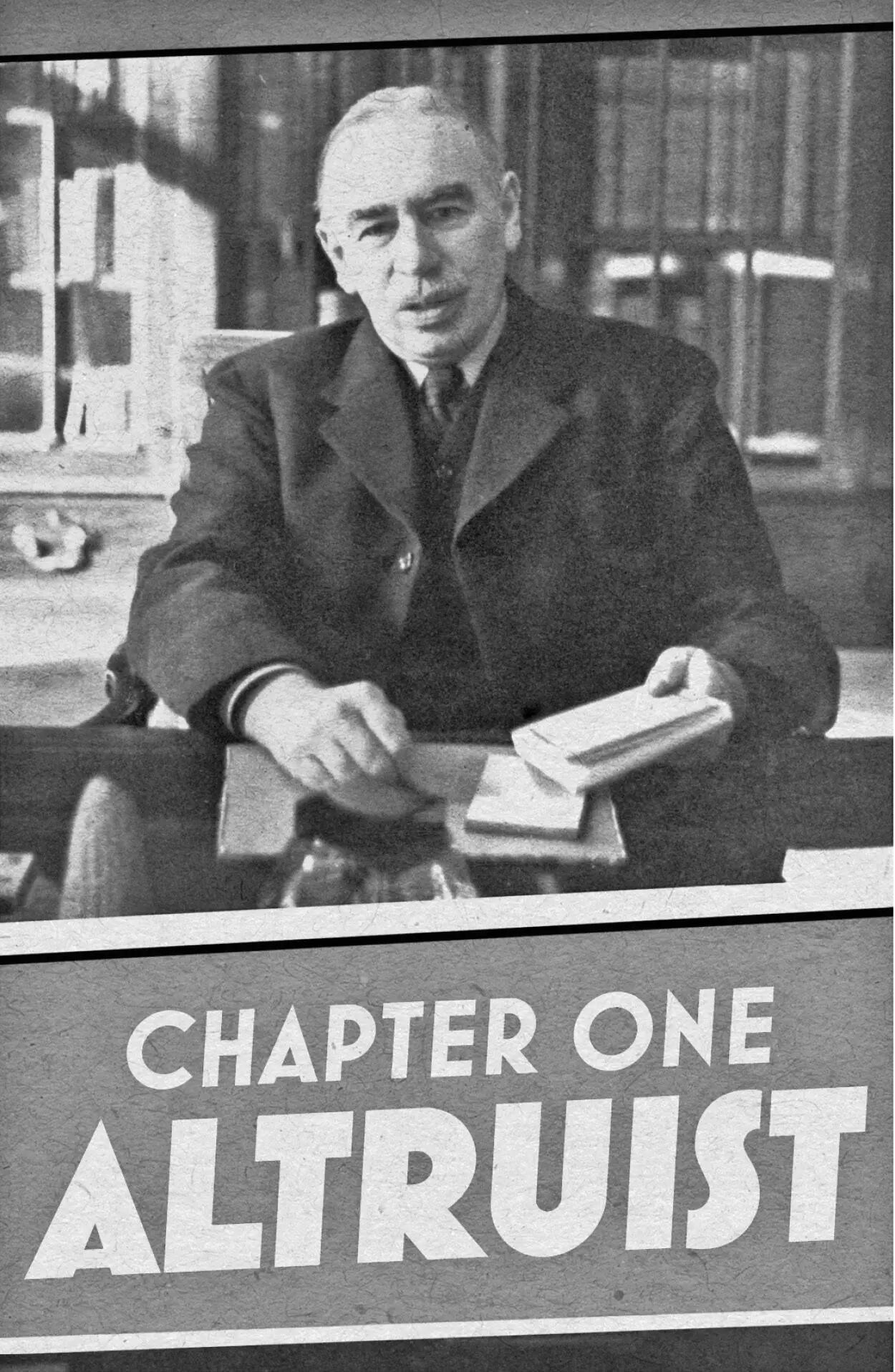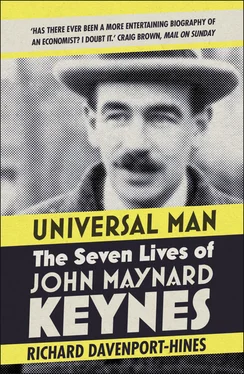List of Illustrations List of Illustrations 1: Maynard Keynes as a figure of intellectual authority and cultural benevolence, surrounded by rare books in his Bloomsbury house. (Tim Gidal/Picture Post/Getty Images) 2: Keynes, aged about fourteen, shortly before starting at Eton, where he won most school prizes and learnt the rudiments of statecraft. (Archives Centre, King’s College, Cambridge; by kind permission of Susannah Burn) 3: ‘The peerless Maynard’ was by his mid-thirties chief of the Treasury department responsible for the London government’s external finances and inter-Allied finance. (Archives Centre, King’s College, Cambridge) 4: Keynes attended the Genoa Conference, which was charged with the conciliation of European capitalism with Russian communism, as special correspondent of the Manchester Guardian . (Private Collection/© Leemage/Bridgeman Images) 5: Duncan Grant with Keynes. In 1908 Keynes wrote to Grant: ‘I want to see you again dreadfully and find that even in the midst of a crowd I am continually sinking into a trance and thinking about you.’ (Private Collection/Bridgeman Images) 6: Bertrand Russell, Keynes and Lytton Strachey in 1915: three Apostles, members of Cambridge’s Immoral Front, conscientious objectors, skirmishers in Bloomsbury’s cultural vanguard. (© National Portrait Gallery, London) 7: Keynes addressing the Bretton Woods monetary and financial conference in 1944. He performed there, he said, the combined tasks of economist, financier, politician, propagandist, lawyer, prophet and soothsayer. (akg-images) 8: Lydia Lopokova and Keynes on their balcony overlooking Gordon Square in 1940. Her protective love and gaiety kept him alive, and enabled his greatest accomplishments. (© Hulton-Deutsch Collection/CORBIS)
Chapter 1: Altruist
Chapter 2: Boy Prodigy
Chapter 3: Official
Chapter 4: Public Man
Chapter 5: Lover
Chapter 6: Connoisseur
Chapter 7: Envoy
Acknowledgements
Notes
Index
Also by Richard Davenport-Hines
About the Author
About the Publisher
1:Maynard Keynes as a figure of intellectual authority and cultural benevolence, surrounded by rare books in his Bloomsbury house. (Tim Gidal/Picture Post/Getty Images)
2:Keynes, aged about fourteen, shortly before starting at Eton, where he won most school prizes and learnt the rudiments of statecraft. (Archives Centre, King’s College, Cambridge; by kind permission of Susannah Burn)
3:‘The peerless Maynard’ was by his mid-thirties chief of the Treasury department responsible for the London government’s external finances and inter-Allied finance. (Archives Centre, King’s College, Cambridge)
4:Keynes attended the Genoa Conference, which was charged with the conciliation of European capitalism with Russian communism, as special correspondent of the Manchester Guardian . (Private Collection/© Leemage/Bridgeman Images)
5:Duncan Grant with Keynes. In 1908 Keynes wrote to Grant: ‘I want to see you again dreadfully and find that even in the midst of a crowd I am continually sinking into a trance and thinking about you.’ (Private Collection/Bridgeman Images)
6:Bertrand Russell, Keynes and Lytton Strachey in 1915: three Apostles, members of Cambridge’s Immoral Front, conscientious objectors, skirmishers in Bloomsbury’s cultural vanguard. (© National Portrait Gallery, London)
7:Keynes addressing the Bretton Woods monetary and financial conference in 1944. He performed there, he said, the combined tasks of economist, financier, politician, propagandist, lawyer, prophet and soothsayer. (akg-images)
8:Lydia Lopokova and Keynes on their balcony overlooking Gordon Square in 1940. Her protective love and gaiety kept him alive, and enabled his greatest accomplishments. (© Hulton-Deutsch Collection/CORBIS)

Seven snapshots of a Universal Man:
An intellectual in his twenties in college rooms in Cambridge, hunched forward listening, lolling back in reflection, then standing on a hearth-rug speaking, eager, testing, provoking, always in passionate, lucid paragraphs, to the secretive discussion group called the Apostles, offering new intellectual or ethical systems, and later acting on his belief in the virtues of immorality, having energetic bouts of illegal, risky sex with men from all classes whom he picked up in museums, saunas, railway stations and streets.
A man of thirty-one perched in the side-car of a motorbike driven by his brother-in-law hurtling at top speed on the dusty hot roads from Cambridge to London on 3 August 1914. The young man is a Cambridge economist, and has been summoned to the Treasury to help with the crisis caused by the looming European war. This heretical outsider single-handedly dissuades the Chancellor of the Exchequer, Lloyd George, and the Treasury mandarins from taking a fatal step that the banks had convinced them was essential: the suspension of the Bank Charter Act. His advice is decisive in averting monetary panic and financial collapse in the first week of the war.
Less than four years later, during a critical phase of the world war, the Treasury official responsible for the government’s external finances persuading the hard-bitten and visually insensitive Chancellor of the Exchequer, Bonar Law, whose home is notorious for its drabness, to allot £20,000 of government money to buy paintings for the National Gallery at the auction of the contents of Degas’ studio; attending the auction in Paris, as the booms of advancing German artillery rattle the confidence of buyers; buying for himself works by Cézanne, Ingres, Delacroix and Degas; carrying the Cézanne back to England in his suitcase, and secreting it in the ditch of a Sussex farm-track, because it is too heavy for him to carry to the friends’ house which he is visiting.
A man in his forties, a member of the Bloomsbury group, art collector, bibliophile, magazine proprietor, balletomane and husband of a dancer in Diaghilev’s Ballets Russes named Lydia Lopokova, stumping round England on behalf of Liberal candidates during general elections, explaining taxation to Blackburn cotton operatives, slumps to Barrow shipyard workers, Russian loans to the shopkeepers of Cambridge, mobbed by railwaymen at Blackpool; becoming an international opinion-former as his articles in the Manchester Guardian are syndicated to newspapers in New York, Berlin, Paris, Milan, Vienna, Amsterdam and Stockholm.
As the Slump hits Britain, and the Great Depression looms over the United States, a Cambridge don leading an informal seminar, lasting several days, for members of a government committee on Finance and Industry, bewitching bankers, manufacturers, officials, trade unionists with piercing new insights (such as the difference between investment and saving) and radical proposals (public-works expenditure by the government to break the vicious cycle of underinvestment, cheap money through low interest rates, tariff barriers to protect home markets, and closing inefficient or surplus factories). ‘You are a complete dramatist,’ the committee chairman Lord Macmillan told him in admiration. His scrupulous, exact and judicious speeches captivate the committee into issuing the Macmillan Report of 1931 calling for a planned economy of a type that would later be known as Keynesian.1
A man in his fifties who knows the creativity of inconsistency, and defines someone of perfect consistency as ‘the man who has his umbrella up whether it rains or not’, revises his ideas, and publishes his General Theory of Employment, Interest and Money in 1936. This founding text (if not the absolutely original creator) of macroeconomics becomes the most important economics book of the twentieth century. It proves as important as Adam Smith’s Wealth of Nations in inaugurating an economic era. ‘We were pedestrian, perhaps a little complacent,’ said A. C. Pigou, a senior Cambridge economist who often resisted his ideas. ‘ General Theory broke resoundingly that dogmatic slumber. Whether in agreement or in disagreement with him discussion and controversy sprang up and spread over the world. Economics and economists came alive. The period of tranquillity was ended. A period of … creative thought was born.’2
Читать дальше













